A Look into the
Bronx County Hall of Justice

 Site:
Site:
Bronx County Hall of Justice
Lesson Plan by:
Sember Weinman, Education Coordinator
Lehman College Art Gallery
Architect:
Rafael Viñoly
Curriculum Link:
New York State Education Department Participation in Government Core Curriculum Guide, Unit D: Legal Obligations
Image © Rafael Viñoly Architects
What interested me was transforming the public’s perception that the building represented an institution that was seen as closed and in need of protection from the community. The [new] building speaks to the participatory and the democratic nature of the judicial system and its fundamental and constructive mission in our society.
-Rafael Viñoly
Project Aim:
In this lesson, students compare the architectural implications of the newly built Bronx County Hall of Justice with the Bronx County Criminal Court that it replaced.
Description:
The Bronx County Hall of Justice, opened in the summer of 2007, is one of the largest courthouses ever built in the United States. The 775,000 square-foot building is nine stories high and covers two full city blocks. Viñoly intended to create a feeling of openness and transparency, a different approach from the typical closed feeling of a traditional courthouse. The building features a glass and aluminum façade that allows all the waiting areas to be filled with natural light. The courtrooms, jury deliberation rooms, and robing rooms, which are all in the interior of the building, have natural light from clerestory windows that borrow daylight from the waiting area corridors.
There are 47 courtrooms, seven grand jury rooms, a large jury assembly room, and space for the Department of Corrections, the Department of Probation, the Bronx District Attorney, and other criminal justice agencies. The jury assembly room is a large cylindrically shaped structure set in the plaza. It is considered the architectural focus of the building. On the north side of the building is a large, open plaza and park. There is also a school adjacent to the courthouse.
The Oklahoma City bombing, which happened after the project began, caused the design team to think about ways to make the glass structure more secure. Bullet-resistant glazing is used in the lobbies and judges’ areas. In high security areas glass is fitted with a ceramic frit to prevent direct viewing from the surrounding buildings. The public plaza, loading dock, and mail room structures are all blast resistant. There are 10 magnetometers and X-ray machines at the main entrance.
The building was designed to be energy efficient in a variety of ways. The windows are designed to capture sunlight for lighting, cooling, and heating systems. The building also has systems that allow for water conservation.
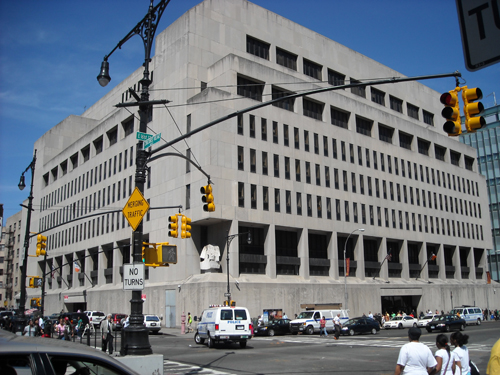 Bronx Family-Criminal Courthouse
Bronx Family-Criminal Courthouse
Historical Precedent:
The Bronx County Hall of Justice was built to relieve overcrowding at the Bronx County Courthouse and the Bronx Family-Criminal Courthouse. The Bronx Family-Criminal Courthouse was built from1973 to 1977 by architects Harrison and Abramowitz. This building was built with a very different philosophy from the new structure. Instead of glass, its exterior is primarily concrete. There are very few windows. This style of architecture was intended to intimidate—a very different statement than that of Rafael Viñoly.
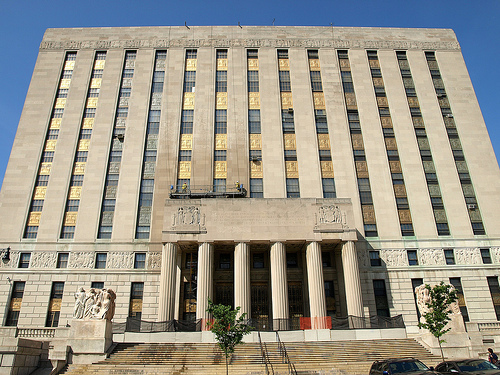 Bronx County Courthouse, image © Mario Burger, 2008
Bronx County Courthouse, image © Mario Burger, 2008
Why use architecture? What can it teach us?
Art is part of the complex structure of beliefs and rituals, social and political systems, and the stories of every human society. In architecture, the structure, function, and purpose of a building is fused seamlessly with the aesthetic, social, and political preferences of a particular time and place. The purpose for a building’s use determines its size, its shape, and the materials chosen. The value that a society places on that purpose is reflected in the decoration, the scale, and the amount of time taken to create a building. Architects choose to borrow styles from the past as their interpretation of a particular philosophy or ideal. Buildings embody cultural values in every tile or stone.
This unit enables students to place architecture within a historical context. As part of their study of the court system in the United States, they will consider the U.S. court system in both theory and practice, and how it is translated through the design of the building in which this process occurs.
Vocabulary:
Façade: The front of a building, esp. an imposing or decorative one. Any side of a building facing a public way or space and finished accordingly.
Clerestory: A portion of an interior rising above adjacent rooftops and having windows admitting daylight to the interior.
Frit: A fused or partially fused material used as a basis for glazes or enamels.
Time Required:
Four class periods plus research that will be conducted as homework.
Materials:
drawing paper (3 sheets per student), pencils, colored pencils, poster board or large sheets of paper, photocopies of Community Board Rubric Worksheet (5 per student).
SESSION ONE:
Students will begin this unit through their study of the United States court system and their study of the rights, responsibilities, and duties of citizenship.
Objective:
Students will be able to determine the rights, responsibilities, and duties of U.S. citizenship, and find a way to represent these values through architecture.
Do Now:
“All fine architectural values are human values, else not valuable.” Frank Lloyd Wright, The Living City, pt. 3, “Recapitulation” (1958).
Respond to this quote. What are values? Are there values in the design of buildings? Give one example to support your idea.
Materials:
Drawing paper and pencils
Activity:
Facilitate a discussion on our relationship with the courts. Ask: What are the rights, responsibilities, and duties of U.S. citizens regarding the law and the courts? Graphically organize student responses by making a column for rights, responsibilities, and duties, and writing down their responses. Is it a right or a duty to serve on a jury? To have a jury make a decision on your case? Do we have a right to a fair trial? What can this list of rights and responsibilities tell us about our values as Americans? Do all people have the same rights and responsibilities?
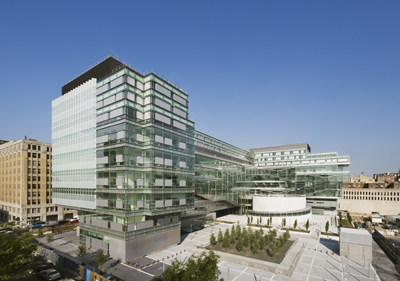 Courtyard, image © Rafael Viñoly Architects
Courtyard, image © Rafael Viñoly Architects
Ask: What would a court look like that embodies the principles that we just discussed? Think about the values that our law makers try to uphold. Can this be shown through architectural values? Create a design drawing of a court façade that represents these ideas. Include notes that describe its features.
Homework:
Conduct research on Rafael Viñoly and the Bronx County Hall of Justice.
SESSION TWO:
Students visit the Bronx County Hall of Justice and the Bronx Family-Criminal Courthouse
Do Now:
On the chalkboard write: Bronx County Hall of Justice, Bronx County Criminal Court. Under each of these titles, make a list of words to describe how you would feel inside this building, based on its title.
Objective:
Students will be able to identify the different values and differing perceptions of our court system projected through the architectural styles of these two buildings.
Activity:
Students tour both courts. They make sketches and take notes on how the two buildings make them feel, what features of the buildings make them feel this way, and whether this agrees with or contradicts the rights and responsibilities that Americans should have in the courts.
Homework:
Students formalize their notes into a one-page essay, comparing the way the architecture reflects the values of the two buildings.
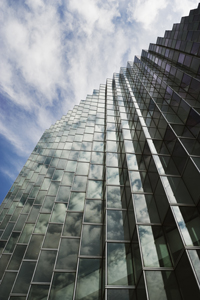 Image © Rafael Viñoly Architects
Image © Rafael Viñoly Architects
SESSION THREE:
Students review their original court design drawings. Drawing from the two courts that they visited, students make revisions to their original design and develop a poster presentation.
Objective:
Students will be able to use their courthouse design drawings to represent their ideas of what our rights, responsibilities, and duties are in the United States Courts.
Do Now:
"We shape our buildings; thereafter they shape us.”
- Winston Churchill
Respond to this quote. What do you think Churchill meant by this statement? Do you agree? Why or why not? What do you think the architects of the buildings we visited yesterday would say about this idea?
Activity:
Introduce vocabulary to students. Ask students to review their original design drawings and develop two new drawings of their courthouse that include any ideas that they developed while visiting the Bronx County Hall of Justice. One drawing should depict the façade, and the other should be an aerial view. Ask them to include notes to explain the features depicted in the drawings. Students collage their drawings together with their notes onto larger sheets of paper or poster board.
Homework:
Students write a one-paragraph statement that expresses the key features of their design. They will read this aloud to the class during session four.
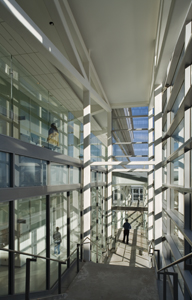 Interior view, image © Rafael Viñoly Architects
Interior view, image © Rafael Viñoly Architects
SESSION FOUR:
Students take turns presenting their ideas to small groups who imagine being representatives of the community in which the court will be built. The reviewers complete rubrics to assess each concept.
Objective:
Students will be able to present and defend their own architectural design ideas to a group. They will also be able to critically assess the appropriateness and effectiveness of the designs of their peers.
Do Now:
If you were a (choose one) juror, lawyer, defendant, family member of defendant, cop, or judge, how would you feel inside the building that you designed? What aspects of your design would make you feel this way?
Activity:
Break students into groups of five or six. Tell them that they are to take turns presenting their ideas to the group. While each idea is being presented, the other members of the group imagine that they are on a community board, deciding whether or not to accept the architect’s proposal. To help them decide, they complete a Community Board Rubric Worksheet. After each presentation the community board members have five minutes to ask the architect questions in order to complete their worksheets. At the end of the class, each student collects the rubrics that were created in response to his or her presentation and turns them in along with the work that was presented.
ASSESSMENT:
At the end of the workshop, students turn in their poster presentations along with their paragraphs and all of the rubrics that were completed for their design.
EXTENSIONS:
1. Students can make revisions based on the rubrics to create a final draft to turn in.
2. Each group can choose the design that they believe to be the most successful, work together to add to or edit the design, and present this final design to the entire class. The entire class can then act as a community board to decide on the architectural design to win the commission.
3. Each group can work together to create a model of their designs.
RESOURCES FOR RESEARCH:
Web
Architectural Record
http://archrecord.construction.com, Bronx County Hall of Justice
New York Construction,
http://newyork.construction.com/projects/...07/TPComplete1-5.pdf
New York State Unified Court System
http://www.courts.state.ny.us/publications/benchmarks/issue5/mega-courthouse.shtml, New York Opens Second Mega-Courthouse, by Anita Womack-Weidner
New York Times
http://nytimes.com, Opening a Courthouse, Overdue and Over Budget, by Timothy Williams
Rafael Vinoly Architects, http://www.rvapc.com/
STANDARDS:
S.S. Standard 1—History of the United States and New York: Students will learn about the development of our constitutional rights, responsibilities, and duties as U.S. citizens.
S.S. Standard 3—Geography: Students will study the physical and social environments surrounding the construction of a community courthouse.
S.S. Standard 5—Civics, Citizenship, and Government: Students will learn about the role that citizens have in shaping our system of law.
Blueprint Strand 1—Arts Making: Students create design drawings of a courthouse.
Blueprint Strand 2—Literacy In the Arts: Students become familiar with the vocabulary and important considerations implicit in architecture.
Blueprint Strand 3—Making Connections: Students apply their understanding of our civic rights, responsibilities, and duties to an architectural design.
Blueprint Strand 4—Community and Cultural Resources: Students take advantage of their access to Bronx Architectural Sites to better understand the purpose and power of architecture both historically and artistically.
Blueprint Strand 5—Careers and Lifelong Learning: Students will obtain exposure to architecture, and various careers within the court system as potential career paths.